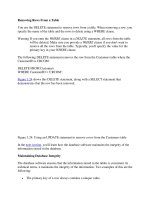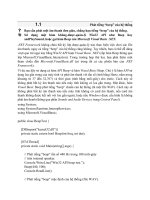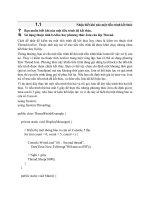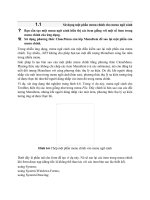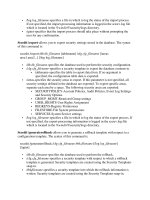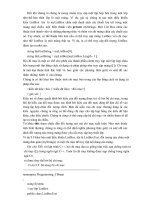Marine Geology Phần 4 doc
Bạn đang xem bản rút gọn của tài liệu. Xem và tải ngay bản đầy đủ của tài liệu tại đây (4.85 MB, 34 trang )
THE MIDOCEAN RIDGES
The shifting lithospheric plates create new oceanic crust in a continuous cycle
of crustal rejuvenation. The subducting lithosphere circulates through the
mantle and reemerges as magma at a dozen or so midocean ridges around the
world, generating more than half of Earth’s crust.The addition of new basalt
on the ocean floor is responsible for the growth of the lithospheric plates
upon which the continents ride.
A large part of this activity takes place in the middle of the Atlantic
Ocean, where molten rock welling up from the upper mantle generates new
sections of oceanic crust.The floor of the Atlantic acts like two opposing con-
veyor belts.The rollers are convection loops in the upper mantle, transporting
oceanic crust in opposite directions outward from its point of origin at the
Mid-Atlantic Ridge.
The spreading ridge system runs from Bovet Island, about 1,000 miles
north of Antarctica, to Iceland, itself a surface expression of the Mid-Atlantic
Ridge (Fig. 64). Extensive volcanism gives rise to volcanic islands such as Surt-
sey (Fig. 65), located 7 miles to the south.The midocean ridge is a string of vol-
canic seamounts, created by molten magma upwelling from within the mantle.
Running down the middle of the ridge crest is a deep trough, as though a giant
crack were carved in the ocean’s crust.This trough reaches 4 miles in depth and
up to 15 miles wide, making it the greatest chasm on Earth.
The submerged mountains and undersea ridges form a continuous chain
46,000 miles long (Fig. 66). It is by far the largest structure on the planet, sur-
passing in scale all mountain ranges on land.The mountainous belt is several
hundred miles wide and up to 10,000 feet above the ocean floor.When start-
ing from the Arctic Ocean, the ridge spans southward across the Atlantic basin;
continues around Africa,Asia, and Australia; runs under the Pacific Ocean; and
terminates at the west coast of North America.
Figure 64 Iceland
straddles the Mid-Atlantic
Ridge.
88
Marine Geology
Greenland
(DENMARK)
ICELAND
0
0
500 Miles
500 Kms
North
Atlantic
Ocean
Norwegian
Sea
N
O
R
W
A
Y
N
The ocean floor at the crest of the ridge consists mainly of basalt, the
most common magma erupted on the surface of Earth. About 5 cubic miles
of new basalt are added to the crust annually, mostly on the ocean floor at
spreading ridges.With increasing distance from the crest, a thickening layer of
sediments shrouds the bare volcanic rock. As the two newly separated plates
move away from the rift, material from the asthenosphere adheres to their
edges to form new lithosphere.The lithospheric plate thickens as it propagates
from a midocean rift system, causing the plate to sink deeper into the mantle.
This is why the seafloor near the continental margins surrounding the Atlantic
basin is the deepest part of the Atlantic Ocean.
Intense seismic and volcanic activity along the midocean ridges manifest
as a high heat flow from Earth’s interior. Molten magma originating from the
mantle rises through the lithosphere and adds new basalt to both sides of the
ridge crest. The greater the flow of magma, the more rapid is the seafloor
spreading and the lower the relief.The spreading ridges in the Pacific Ocean
are more active than those in the Atlantic and therefore are less elevated.
Rapidly spreading ridges do not achieve the heights of slower ones simply
because the magma does not have sufficient time to pile up into tall heaps.
Figure 65 Birth of the
new Icelandic island,
Surtsey, in November
1963, located 7 miles
south of Iceland.
(Photo courtesy U.S. Navy)
89
Ridges and Trenches
The axis of a slow-spreading ridge is characterized by a rift valley several miles
deep and about 10 to 20 miles wide.
A set of closely spaced fracture zones dissects the Mid-Atlantic Ridge in
the equatorial Atlantic.The largest of these structures is the Romanche Frac-
ture Zone (Fig. 67). It offsets the axis of the ridge in an east-west direction by
nearly 600 miles. The floor of the Romanche trench is as much as 5 miles
below sea level.The highest parts of the ridges on either side of the trench are
less than 1 mile below sea level.This provides a vertical relief of four times that
of the Grand Canyon.
The shallowest portion of the ridge is capped with a fossil coral reef, sug-
gesting it was above sea level some 5 million years ago. Many similar and
equally impressive fracture zones span the area, culminating in a sequence of
troughs and transverse ridges several hundred miles wide.The resulting terrain
is unmatched in size and ruggedness anywhere else in the world.
In the Pacific Ocean, a rift system called the East Pacific Rise stretches
6,000 miles from the Antarctic Circle to the Gulf of California. It lies on the
eastern edge of the Pacific plate, marking the boundary between the Pacific
and Cocos plates. It is the counterpart of the Mid-Atlantic Ridge and a mem-
ber of the world’s largest undersea mountain chain. The rift system is a net-
work of midocean ridges, which lie mostly at a depth of about 1.5 miles. Each
rift is a narrow fracture zone, where plates of the oceanic crust diverge at an
average rate of about 5 inches a year.This results in less topographical relief on
the ocean floor. The active tectonic zone of a fast spreading ridge is usually
quite narrow, generally less than 4 miles wide.
Figure 66 Midocean
ridges that wind around
the world’s ocean basins
are composed of individual
volcanic spreading centers.
90
Marine Geology
THE HEAT ENGINE
All geologic activity that continuously shapes the surface of Earth is an out-
ward expression of the great heat engine in the interior of the planet. The
motion of the mantle churning over ever so slowly below the crust brings
heat from the core to the surface by convection loops (Fig. 68), the main dri-
ving force behind plate tectonics. Convection is the motion within a fluid
medium that results from a difference in temperature from the bottom to the
top.The core transfers heat to mantle rocks, whose increased buoyancy causes
them to rise to the surface.
Convection currents and mantle plumes transport molten magma to the
underside of the lithosphere, which is responsible for most of the volcanic
Figure 67 The
Romanche Fracture Zone
is the largest offset of the
Mid-Atlantic Ridge.
91
Ridges and Trenches
0º
C
A
M
E
R
O
O
N
South Atlantic
Ocean
North Atlantic
Ocean
E
q
u
a
t
o
r
SOUTH
AMERICA
AFRICA
M
I
D
-
A
T
L
A
N
T
I
C
R
I
D
G
E
M
I
D
-
A
T
L
A
N
T
I
C
R
I
D
G
E
Romanche
Cape of
Good Hope
activity on the ocean floor and on the continents. Most mantle plumes orig-
inate from within the mantle. However, some arise from the very bottom of
the mantle, making it a huge, bubbling pot stirred throughout its entire depth.
The formation of molten rock and the rise of magma to the surface
results from an exchange of heat within the planet’s interior. Fluid rocks in the
mantle acquire heat from the core, ascend, dissipate heat to the lithosphere,
cool, and descend back to the core to be reheated.The mantle currents travel
very slowly, completing a single convection loop in several hundred million
years.
Earth is steadily losing heat from its interior to the surface through the
lithosphere.About 70 percent of this heat loss results from seafloor spreading.
Most of the rest is due to volcanism at subduction zones (Fig. 69). Lithos-
pheric plates created at spreading ridges and destroyed at subduction zones are
the final products of convection currents in the mantle.
Most of the mantle’s heat originates from internal radiogenic sources.
The rest comes from the core, which has retained much of its original heat
since the early accretion of Earth some 4.6 billion years ago.The temperature
difference between the mantle and the core is nearly 1,000 degrees Celsius.
Material from the mantle might be mixing with the fluid outer core to form
a distinct layer on the surface that could block heat flowing from the core to
the mantle and interfere with mantle convection.
Figure 68 Convection
currents in the mantle
move the continents
around Earth.
92
Marine Geology
Core
Outer
core
R
i
d
g
e
Heat transferred from the mantle to the asthenosphere causes convection
currents to rise and travel laterally when reaching the underside of the lithos-
phere. Upon giving up their heat energy to the lithosphere, the currents cool
and descend back into the mantle in a manner similar to air currents in the
atmosphere. If any cracks or areas of weakness occur in the lithosphere, the
convective currents spread the fissures wider apart to form undersea spreading
ridges in the ocean and rift systems on the continents (Fig. 70). Here the
largest proportion of Earth’s interior heat is lost to the surface as magma flows
out of the rift zones.
The mantle rocks are churning over very slowly in large-scale convec-
tion loops. They travel only a couple inches a year, about the same as plate
movements, providing no slippage occurs at the contact between plate and
mantle.The convection currents might take hundreds of millions of years to
complete a single loop. Some of these loops can be extremely large in the
horizontal dimension and correspond to the dimensions of the associated
plate. In the case of the Pacific plate, the loop would have to reach some
6,000 miles across.
Besides these large-scale features, small-scale convection cells might
exist.Their horizontal dimensions would be comparable to a depth of about
410 miles, corresponding to the thickness of the upper mantle. Hot mater-
ial rises from within the mantle and circulates horizontally near Earth’s sur-
face.There the top 30 miles or so cools to form the rigid plates, which carry
the crust around. The plates complete the mantle convection by plunging
Figure 69 The
subduction of a
lithospheric plate into the
mantle supplies volcanoes
with molten magma.
93
Ridges and Trenches
S
u
b
d
u
c
t
i
o
n
z
o
n
e
back into Earth’s interior.Thus, they are merely surface expressions of man-
tle convection.
Convection in the mantle would be expected to be strongly influenced
by Earth’s rotation.This is similar to the rotation’s influence on air and ocean
currents by the Coriolis effect, which bends poleward-flowing currents to
the west and equatorward-flowing currents to the east (see chapter 6 for
more on the Coriolis effect).Yet the rotation does not seem to affect the
mantle. Even if convective flow occurred, it might not exist in neat circular
cells. Instead, it might create eddy currents. The flow would thus become
turbulent and extremely complex. Furthermore, the mantle is heated not
only from below, but like the crust it is also heated from within by radio-
active decay. This further complicates the development of convection cells
Figure 70 The rifting
of the African continent is
occurring in the Red Sea,
the Gulf of Aden, the
Ethiopian rift valley, and
the East African Rift.
94
Marine Geology
800 Kms0
800 Miles0
N
Rift valley
Lake
Tanganyika
Lake
Malawi
Lake
Victoria
Atlantic Ocean
Indian
Ocean
Mediterranean Sea
Red Sea
Gulf of Aden
Lake
Tanganyika
Lake
Malawi
Lake
Victoria
E
a
s
t
e
r
n
R
i
f
t
W
e
s
t
e
r
n
R
i
f
t
AFRICA
and causes distortion because the interior of the cells would no longer be
passive.The interior would instead provide a significant portion of the heat
as well.
Convection currents transport heat by the motion of mantle material,
which in turn drives the plates. The mantle convection currents are believed
to originate more than 410 miles below the surface. The deepest known
earthquakes are detected at this level. Since plate motions trigger almost all
large earthquakes, the energy they release must come from the forces that
drive the plates.At the plate boundaries where one plate dives under another,
the sinking slab meets great resistance to its motion at a depth of about 410
miles. This is the boundary between the upper and lower mantle, where the
slabs tend to pile up.
However, sinking ocean crust has been known to breach this barrier and
sink as much as 1,000 miles or more below the surface. Seismic images of
mantle downwelling beneath the west coast of the Americas show a slab of
subducting Pacific Ocean floor diving down to the very bottom of the man-
tle. Another slab of ancient ocean floor is sinking under the southern margin
of Eurasia and is thought to be the floor of the Tethys, an ancient sea that sep-
arated India and Africa from Laurasia. Ocean slabs are also sinking into the
mantle beneath Japan, eastern Siberia, and the Aleutian Islands.
If a slab should sink as far as the bottom of the lower mantle, it might
provide the source material for mantle plumes called hot spots. If all
oceanic plates were to sink to this level, a volume of rock equal to that of
the entire upper mantle would be thrust into the lower mantle every 1 bil-
lion years. In order for the two mantle layers to maintain their distinct
compositions, one floating on the other like oil on water, some form of
return flow back to the upper mantle would be needed. Hot-spot plumes
seem to fulfill this function.
The convection cells might also be responsible for the rising jets of
magma that create chains of volcanoes, such as the Hawaiian Islands (Fig.
71). A strong mantle current possibly runs beneath the islands and disrupts
the plume of ascending hot rock. Instead of rising vertically, the plume
is sheared into discrete blobs of molten rock that climb like balloons in
the wind. Each small plume created a line of volcanoes pointing in the
direction of the movement of the underlying mantle. This might explain
why the Hawaiian volcanoes do not line up exactly and why they erupt
dissimilar lavas.
The asthenosphere is constantly losing material, which escapes from
midocean ridges and adheres to the undersides of lithospheric plates. If the
asthenosphere were not continuously fed new material from mantle plumes,
the plates would grind to a complete halt. Earth would then become, in all
respects, a dead planet because all geologic activity would cease.
95
Ridges and Trenches
SEAFLOOR SPREADING
Seafloor spreading creates new lithosphere at spreading ridges on the ocean
floor. It begins with hot rock rising from deeper portions of the mantle by
convection currents.After reaching the underside of the lithosphere, the man-
tle rock spreads out laterally, dissipates heat near the surface, cools, and
descends back into the deep interior of the Earth, where it receives more heat
in a repeated cycle.
The constant pressure against the bottom of the lithosphere fractures the
plate and weakens it. Convection currents flowing outward on either side of
the fracture carry the separated parts of the lithosphere along with them,
widening the gap.The rifting reduces the pressure in the underlying mantle,
allowing mantle rocks to melt and rise through the fracture zone.
Figure 71 Photograph
of the Hawaiian Island
chain looking south, taken
from the space shuttle.The
main island, Hawaii, is in
the upper portion of the
photograph.
(Photo courtesy NASA)
96
Marine Geology
The molten rock passes through the lithosphere and forms magma cham-
bers that supply molten rock for the generation of new lithosphere. Crustal
material is sometimes introduced into the deep magma sources by subduction
or off-scraping of a continental margin.The magma reservoirs resemble a mush-
room up to 6 miles wide and 4 miles thick. The greater the supply of magma
to the chambers, the higher they elevate the overlying spreading ridge.
As magma flows outward from the trough between ridge crests, it adds
layers of basalt to both sides of the spreading ridge, creating new lithosphere.
Some molten rock overflows onto the ocean floor in tremendous eruptions
that generate additional oceanic crust. The continents ride passively on the
lithospheric plates created at spreading ridges and destroyed at subduction
zones. Therefore, the engine that drives the birth and evolution of rifts and,
consequently, the breakup of continents and the formation of oceans ulti-
mately originates in the mantle.
The plates grow thicker as they move away from a midocean spreading
ridge as material from the asthenosphere adheres to the underside of the plates
and transforms into new oceanic lithosphere. The continental plates vary in
thickness from 25 miles in the young geologic provinces, where the heat flow
is high, to 100 miles or more under the continental shields, where the heat flow
is much lower.The shields are so thick they can actually scrape the bottom of
the asthenosphere.The drag acts as an anchor to slow the motion of the plate.
The spreading ridges are the sites of frequent earthquakes and volcanic
eruptions.The entire system acts as though it was a series of giant cracks in
Earth’s crust from which molten magma leaks out onto the ocean floor. Over
much of its length, the ridge system is carved down the middle by a sharp
break or rift that is the center of an intense heat flow. Magma oozing out at
spreading ridges erupts basaltic lava through long fissures in the trough
between ridge crests and along lateral faults. The faults usually occur at the
boundary between lithospheric plates, where the oceanic crust pulls apart by
the plate separation. Magma welling up along the entire length of the fissure
forms large lava pools that harden to seal the fracture.
The spreading ridge system is not a continuous mountain chain.
Instead, it is broken into small, straight sections called spreading centers (Fig.
72). The movement of new lithosphere generated at the spreading centers
produces a series of fracture zones.These are long, narrow, linear regions up
to 40 miles wide that consist of irregular ridges and valleys aligned in a stair-
step shape. When lithospheric plates slide past each other as the seafloor
spreads apart, they create transform faults ranging from a few miles to sev-
eral hundred miles long. They are so named because they transform from
active faults between spreading ridge axes to inactive fracture zones past the
ridge axes. The transform faults partition the midocean ridge system into
independent segments, each with their individual volcanic sources.
97
Ridges and Trenches
The transform faults of the Mid-Atlantic Ridge are offset laterally in a
roughly east-west direction.The faults occur every 20 to 60 miles along the
midocean ridge.The longer offsets consist of a deep trough joining the tips of
two segments of the ridge. Other types of offsets up to 15 miles wide separate
several spreading centers, which are each 20 to 30 miles long.The end of one
spreading center often runs past the end of another. Sometimes the tips of the
segments bend toward each other. Friction between segments produces strong
shearing forces that wrench the ocean floor into steep canyons.
Transform faults appear to result from lateral strain, which is how rigid
lithospheric plates are expected to react on the surface of a sphere.This activ-
ity is more intense in the Atlantic, where the spreading ridge system is steeper
and more jagged than in the Pacific and Indian Oceans.Transform faults dis-
secting the Mid-Atlantic Ridge are generally more rugged than those of the
East Pacific Rise. Moreover, fewer widely spaced transform faults exist along
the East Pacific Rise, where the rate of seafloor spreading is five to 10 times
faster than at the Mid-Atlantic Ridge.Therefore, the crust affected by trans-
form faults is younger, hotter, and less rigid in the Pacific than in the Atlantic,
giving the Pacific undersea terrain much less relief.
BASALTIC MAGMA
Most of Earth’s surface above and below the sea is of volcanic origin. About
80 percent of all oceanic volcanism occurs along spreading ridges, where
Figure 72 Spreading
centers on the ocean floor
are separated by transform
faults.
98
Marine Geology
magma welling up from the mantle spews out onto the ocean floor. The
seafloor on the crest of the midocean ridge consists of hard volcanic rock.The
spreading crustal plates grow by the steady accretion of solidifying magma.
The molten magma beneath the spreading ridges consists mostly of peridotite,
an iron-magnesium silicate.
As the peridotite melts while rising through the lithosphere, a portion
becomes highly fluid basalt. More than 1 square mile of new ocean crust,
comprising about 5 cubic miles of basalt, forms throughout the world annu-
ally in this manner. However, sometimes gigantic flows erupt on the ocean
floor with enough new basalt to pave the entire U.S. interstate highway sys-
tem 10 times over.
Mantle material extruding onto the surface is black basalt, which is
rich in silicates of iron and magnesium. Most of the world’s nearly 600 active
volcanoes are entirely or predominately basaltic. The magma from which
basalt forms originated in a zone of partial melting in the upper mantle
more than 60 miles below the surface.The semimolten rock at this depth is
less dense than the surrounding mantle material and rises slowly toward the
surface. As the magma ascends, the pressure decreases and more mantle
material melts.Volatiles such as dissolved water and gases aid in making the
magma flow easily.
Magma rising toward the surface fills shallow reservoirs or feeder pipes
that are the immediate source of volcanic activity. The magma chambers
closest to the surface exist under spreading ridges, where the oceanic crust is
only 6 miles thick or less. Large magma chambers lie under fast spreading
ridges where the lithosphere forms at a high rate, such as those in the Pacific.
Narrow magma chambers lie under slow spreading ridges such as those in
the Atlantic.
As the magma chamber swells with molten rock and begins to expand,
the crest of the spreading ridge bulges upward due to the buoyant forces gen-
erated by the magma.The greater the supply of molten magma, the higher it
elevates the overlying ridge segment.The magma rises in narrow plumes that
balloon out along the spreading ridge, upwelling as a passive response to the
release of pressure from plate divergence, somewhat like having the lid taken
off a pressure cooker. Only the center of the plume is hot enough to rise all
the way to the surface, however. If the entire plume erupted, it would build a
massive volcano several miles high that would rival the tallest volcanoes in the
solar system.
When the magma reaches the surface, it erupts a variety of gases, liq-
uids, and solids.Volcanic gases mostly consist of steam, carbon dioxide, sulfur
dioxide, and hydrochloric acid. The gases are dissolved in the magma and
released as it rises toward the surface and pressures decrease.The composition
of the magma determines its viscosity and type of eruption, whether quiet or
99
Ridges and Trenches
explosive. If the magma is highly fluid and contains little dissolved gas when
reaching the surface, it flows from a volcanic vent or fissure as basaltic lava.
In such a case, the eruption is usually quite mild, as with Hawaiian Island
volcanoes (Fig. 73).
The main types of lava formations associated with midocean ridges are
sheet flows and pillow, or tube flows, which form pillow lavas (Fig. 74). Sheet
flows are more prevalent in the active volcanic zone of fast spreading ridge seg-
ments such as those of the East Pacific Rise, where in some places the plates
separate at a rate of 5 or more inches per year.These flows consist of flat slabs
of basalt usually less than 1 foot thick. The basalt that forms sheet flows is
more fluid than that responsible for pillow structures. Pillow lavas often occur
at slow spreading ridges, such as at the Mid-Atlantic Ridge.There plates sep-
arate at a rate of only about 1 inch per year and the lava is much more viscous.
The manufacture of new oceanic crust in this manner explains why some of
the most intriguing terrain features lie on the bottom of the ocean
The Gorda Ridge, a deep-sea mountain range off the Northwest coast,
forms where two oceanic plates abut one another.As the plates pull apart, they
open up a crack that allows lava to rise from deep inside Earth. Oceanogra-
phers listening in on the Pacific Ocean through undersea microphones,
Figure 73 An aa lava
flow entering the sea from
the January 21, 1960,
eruption of Kilauea,
Hawaii.
(Photo by D. H. Richter,
courtesy USGS)
100
Marine Geology
planted on the seabed by the U.S. Navy to track submarines, heard the sound
of a volcanic eruption along the Gorda Ridge. When researchers visited the
ridge a few days later, they witnessed the actual birth of new ocean floor by
seafloor spreading.While the eruption was in progress, they found a large pool
of warmed water just above the ridge, whose summit at that point was 10,000
feet below sea level.After returning with a remote camera, they spotted fresh
lava that had recently erupted.This was one of only a few times that scientists
have caught seafloor spreading in the act.
THE CIRCUM-PACIFIC BELT
Deep-sea trenches, where the ocean floor disappears into Earth’s interior, ring
the Pacific. Lithospheric plates descend sheetlike into the mantle at subduc-
tion zones lying off continental margins and adjacent to island arcs. Plate sub-
duction is responsible for the intense seismic activity that fringes the Pacific
Ocean in a region known as the circum-Pacific belt, a chain of subduction
zones flanking the Pacific basin.
Most earthquakes originate at plate boundaries (Fig. 75).Wide bands of
earthquakes mark continental plate margins. Narrow bands of earthquakes
Figure 74 Pillow lava
on Knight Island, Alaska.
(Photo by F. H. Moffit,
courtesy USGS)
101
Ridges and Trenches
mark many major oceanic plate boundaries. The most powerful quakes are
associated with plate subduction where one plate thrusts under another in
deep subduction zones. The greatest amount of seismic energy occurs along
the rim of the Pacific Ocean. In the western Pacific, the circum-Pacific belt
encompasses volcanic island arcs that fringe the subduction zones, producing
some of the largest earthquakes in the world.
The circum-Pacific belt is also known for its extensive volcanic activity.
Subduction zone volcanoes form island arcs, mostly in the Pacific, and most
volcanic mountain ranges on the continents.The circum-Pacific belt coincides
with the Ring of Fire.The same tectonic forces that produce earthquakes are
responsible for volcanic activity. This explains why the Pacific rim also con-
tains the majority of the world’s active volcanoes. The area of greatest seis-
micity is on the plate boundaries associated with deep trenches and volcanic
island arcs, where an oceanic plate dives under a continental plate.
When starting from New Zealand, a land traversed by earthquake faults
(Fig. 76), the circum-Pacific belt runs northward. It encompasses the islands of
Tonga, Samoa, Fiji, the Loyalty Islands, the New Hebrides, and the Solomons.
The belt then runs westward to embrace New Britain, New Guinea, and the
Moluccas Islands. One segment continues westward over Indonesia. However,
Figure 75 Most
earthquakes occur in broad
zones associated with
plate boundaries.
102
Marine Geology
0
0
2000 kilometers
2000 miles
Infrequent land tremors
Frequent land tremors
Submarine tremors
Pacific Ocean
Atlantic Ocean
Indian
Ocean
Pacific Ocean
the principal arm travels northward to encompass the Philippines, where a
large fault zone runs from one end of the islands to the other.The seismic belt
continues on to Taiwan and the Japanese archipelago, which has been hard hit
by major earthquakes.The January 17, 1995, Kobe earthquake of 7.2 magni-
tude killed more than 5,500 people and destroyed over $100 billion worth of
property.
An inner belt runs parallel to the main belt and takes in the Marianas.
This string of volcanic islands is characterized by a massive trench system in
places more than 30,000 feet deep. The belt continues northward and fol-
lows the seismic arc across the top of the Pacific. It comprises the Kuril
Islands (devastated by an 8.2 magnitude earthquake on October 4, 1994), the
Kamchatka Peninsula, and the Aleutian Islands, which constantly rock and
Figure 76 The
Wellington Fault, New
Zealand.
(Photo courtesy USGS)
103
Ridges and Trenches
roll. The Aleutian Trench, the largest on Earth, is responsible for the many
great earthquakes that strike Alaska. A 200-mile-long stretch called the Shu-
magin gap, which is accumulating huge stresses in the descending Pacific
plate, is poised for a massive earthquake.
Figure 77 The
subduction of the Juan de
Fuca plate into the
Cascadia subduction zone
is responsible for the
volcanoes of the Cascade
Range.
104
Marine Geology
San Andreas Fault
Juan de Fuca
Ridge-Rift
Feature
UNITED STATES
North
American
Plate
Pacific
Plate
Pacific Ocean
CANADA
MEXICO
C
a
s
c
a
d
e
R
a
n
g
e
S
i
e
r
r
a
N
e
v
a
d
a
C
o
a
s
t
M
t
s
.
S
i
e
r
r
a
M
a
d
r
e
When crossing over to the eastern side of the Pacific basin, the seismic
belt continues along the Cascadia subduction zone (Fig. 77). It extends along
the coast from southern British Columbia to northern California. This belt
has severely shaken the Pacific Northwest in the geologic past and is respon-
sible for numerous powerful volcanoes. The Juan de Fuca and Gorda plates
slipping under the North American plate generate the tectonic activity.
The San Andreas Fault marks the boundary between the North Ameri-
can and Pacific plates and rattles much of California (Fig. 78). The fault is a
huge fracture zone 650 miles long and 20 miles deep. It runs northward from
the Mexican border through southern California and plunges into the ocean
at Cape Mendocino 100 miles south of the Oregon border.The fault repre-
sents the margin between the Pacific plate and the North American plate,
which are moving relative to each other in a right lateral direction at a rate of
nearly 2 inches per year.When the two plates snag and try to tear free of each
other, earthquakes rumble across the region.
The mountain ranges of Mexico and Central America and the Andes
Mountain regions of South America, especially in Chile and Peru, have been
lashed by some of the largest and most destructive earthquakes. The 1960
Chilean earthquake of 9.5 magnitude, the largest in modern history, elevated
a California-sized chunk of crust some 30 feet. In June 2001, Chile was struck
again by a massive 8.1 magnitude earthquake that leveled cities and killed peo-
Figure 78 Collapsed
buildings in the Marina
District caused by the
October 17, 1989, Loma
Prieta earthquake, San
Francisco, California.
(Photo by G. Plafker,
courtesy USGS)
105
Ridges and Trenches
ple by the hundreds. In the last century, some two dozen earthquakes of 7.5
magnitude or greater have devastated the region.
An immense subduction zone lying just off the coast influences the
whole western seaboard of South America. The lithospheric plate on which
the South American continent rides forces the Nazca plate to buckle under,
causing great tensions to build deep within the crust.The ocean floor’s descent
into the mantle is accompanied by devastating earthquakes as it grinds under
the adjacent plate. While some rocks shove downward, others thrust to the
surface to raise the Andes Mountains, making them the fastest growing moun-
tain range on Earth. The resulting forces build great stresses into the entire
region and, as the strain builds and the crust cracks, great earthquakes roll
across the countryside.
THE DEEP-SEA TRENCHES
The creation of new lithosphere at midocean ridges is matched by the
destruction of old lithosphere at subduction zones (Fig. 79). Deep trenches
lying at the edges of continents or along volcanic island arcs mark the seaward
boundaries of the subduction zones. As a lithospheric plate sinks into the
mantle, the line of subduction creates a deep-sea trench. While the Pacific
plate drifts toward the northwest, its leading edge dives into the mantle, form-
Figure 79 The
subduction zones where
lithospheric plates enter
the mantle are marked by
the deepest trenches in the
world.
106
Marine Geology
Tonga
Cascadia
Cocos
New
Guinea
Caribbean
Scotia
Peru-
Chile
Philippine
Java
Java
Mariana
Japan
Aleutian
ing the deepest trenches in the world (Table 10).The Mariana Trench in the
western Pacific is the lowest point on Earth. It extends northward from the
Island of Guam in the Mariana Islands and reaches a depth of nearly 7 miles
below sea level.
Subduction zones, where cool, dense lithospheric plates dive into the
mantle, are regions of low heat flow and high gravity (an area where the grav-
itational pull is strong relative to the average force of gravity on the surface).
Conversely, because of their extensive volcanic activity, the associated island
arcs are regions of high heat flow and low gravity.The deep-sea trenches are
regions of intense volcanism, producing the most explosive volcanoes on
Earth.Volcanic island arcs, which typically share similar curved shapes and sim-
ilar volcanic origins, fringe the trenches.These island chains, for example the
Aleutian Islands, are generally arc shaped because of the geometry of the
ocean floor. The trenches outline an arc because this is the geometric figure
formed when a plane cuts a sphere in the same manner that a rigid lithos-
pheric plate subducts into the spherical mantle.
The trenches are also sites of almost continuous earthquake activity deep
in the bowels of Earth, about 2 miles down. Plate subduction causes stresses to
build into the descending lithosphere, producing deep-seated earthquakes that
outline the boundaries of the plate. A band of shallow earthquakes clustered
in a line running through Micronesia appears to mark the earliest stages in the
birth of a subduction zone, indicated by the formation of a trench to the north
and west of New Guinea in the western Pacific. Gravity in the area is lower
107
Ridges and Trenches
TABLE 10 THE WORLD’S OCEAN TRENCHES
Trench Depth (miles) Width (miles) Length (miles)
Peru–Chile 5.0 62 3,700
Java 4.7 50 2,800
Aleutian 4.8 31 2,300
Middle America 4.2 25 1,700
Marianas 6.8 43 1,600
Kuril-Kamchatka 6.5 74 1,400
Puerto Rico 5.2 74 960
South Sandwich 5.2 56 900
Philippines 6.5 37 870
Tonga 6.7 34 870
Japan 5.2 62 500
than normal, as expected over a trench due to the sagging of the ocean floor.
In addition, a bulge in the crust to the south of this area suggests that the edge
of a slab of crust is beginning to dive into the mantle.The subduction process
might not be operating fully for another 5 or 10 million years as the deep-sea
trench nibbles away at the Pacific plate.
The seafloor south of New Zealand could also be experiencing the early
stages of subduction in the process of creating a deep-sea trench. A geologic
scar on the floor of the Pacific known as the Macquarie Ridge (Fig. 80) is still
evolving as part of this process. The ridge is an undersea chain of mountains
and troughs running south from New Zealand. It forms the boundary
between the Australian and Pacific plates, which pass each other in opposite
directions as the Australian plate moves northwest in relation to the Pacific
plate.As a result of this action, in 1989, a massive earthquake of magnitude 8.2
struck the ridge.
As the Australian plate slides by the Pacific plate, ruptures occur along
vertical faults where the plates slip past each other, creating large strike-slip
Figure 80 The location
of the Macquarie Ridge
south of New Zealand.
108
Marine Geology
Indian Ocean
AUSTRALIA
Earthquake
NEW
ZEALAND
M
A
C
Q
U
A
R
I
E
R
I
D
G
E
earthquakes. As they pass one another, the plates are also pressing together
along dipping fault planes, creating smaller compressional earthquakes. This
action suggests that subduction is just beginning along the Macquarie Ridge.
However, the separate dipping faults that flank the area have not yet con-
nected to form a single large fault plane, a necessary first step before subduc-
tion commences.
A plate extending away from its place of origin at a midocean spreading
ridge becomes thicker and denser as additional material from the asthenos-
phere adheres to its underside in a process called underplating.The depth at
which the oceanic crust sinks as it moves away from the midocean ridges
varies with its age.Thus, the older the lithosphere the more basalt that under-
plates it, making the plate thicker, denser, and deeper.
Eventually, the plate becomes so dense it loses buoyancy and sinks into
the mantle.The line of subduction creates a deep-sea trench at clearly defined
subduction zones, where cool, dense lithospheric plates dive into the mantle.
As the subducted portion of the plate dives into Earth’s interior, the rest of the
plate, which might carry a continent on its back, is pulled along with it like a
freight train being hauled by a locomotive. Plate subduction is therefore the
main driving force behind plate tectonics, and pull at subduction zones is
favored over push at spreading ridges to move the continents around the sur-
face of the globe.
New oceanic crust generated by seafloor spreading in the Atlantic and
eastern Pacific is offset by the subduction of old ocean crust along the rim
of the Pacific to make more room. Because the seafloor spreading rate is
not always the same as the rate of subduction, associated midocean ridges
often move laterally. Most subduction zones are in the western Pacific,
which accounts for the fact that most oceanic crust is no older than 170
million years.
Subduction zones are the sites of almost continuous seismic activity.The
band of earthquakes marks the boundaries of a sinking lithospheric plate (Fig.
81). As plates slide past each other along subduction zones, they create highly
destructive earthquakes, such as those that have always plagued Japan, the
Philippines, and other islands connected with subduction zones.
The subduction zones are also regions of intense volcanic activity, pro-
ducing the most explosive volcanoes on the planet. Magma reaching the sur-
face erupts on the ocean floor, creating new volcanic islands. Most volcanoes
do not rise above sea level, however. Instead, they become isolated undersea
volcanic structures called seamounts. The Pacific basin is more volcanically
active and has a higher density of seamounts than the Atlantic or Indian basins.
Subduction zone volcanoes are highly explosive because their magmas con-
tain large quantities of volatiles and gases that escape violently when reaching
the surface.The type of volcanic rock erupted in this manner is called andesite,
109
Ridges and Trenches
named for the Andes Mountains that form the spine of South America and
well-known for their violent eruptions.
PLATE SUBDUCTION
The push that plates received from the expansion of the ocean floor at spread-
ing ridges was once thought to be sufficient to force oceanic crust into the
mantle at subduction zones. However, drag at the base of the plates can greatly
resist plate motion. Therefore, an additional source of energy is needed to
drive the plates. For this purpose, the force of gravity is called upon to pro-
vide the driving mechanism to overcome the resistance caused by plate drag.
Therefore, the pull of a sinking slab of oceanic crust is the strongest force
moving the plates around the surface of the globe.
An additional force that might help to overcome the resistance caused
by plate drag is the pull the sinking plate receives by mantle convection cur-
rents.The magnitude of this force depends on the length of the subduction
zone, the rate of subduction, and the amount of trench suction. With these
forces in place, the plates could practically drive themselves without the aid of
seafloor spreading.Therefore, the upwelling of magma at midocean spreading
ridges might simply be a passive response to the plates being pulled apart by
subduction.
Figure 81 A cross
section of a descending
lithospheric plate. Os
denotes shallow
earthquakes. Xs denotes
deep-seated earthquakes.
110
Marine Geology
x
x
x
x
x
x
x
x
x
o
o
o
o
o
o
o
o
o
o
o
o
o
x
x
Asthenosphere
L
i
t
h
o
s
p
h
e
r
e
L
i
t
h
o
s
p
h
e
r
e
As the rigid lithospheric plate carrying the oceanic crust descends into
Earth’s hot interior, it slowly breaks up and melts. Over a period of millions
of years, it is absorbed into the general circulation of the mantle. When the
plate dives into the interior, most of its trapped water goes down with it,
becoming an important volatile in magma.The subducted plate also supplies
molten magma for volcanoes, most of which ring the Pacific Ocean and recy-
cle chemical elements to the planet.
The amount of subducted plate material is vast. When the Atlantic and
Indian Oceans opened up and began forming new oceanic crust some 125
million years ago, an equal area of oceanic crust disappeared into the mantle.
This meant that 5 billion cubic miles of crustal and lithospheric material was
destroyed. At the present rate of subduction, the mantle will consume an area
equal to the entire surface of the planet in just 160 million years.
The convergence of lithospheric plates forces the thinner, more dense
oceanic plate under the thicker, more buoyant continental plate. When
oceanic plates collide, the older and denser plate dives under the younger plate
(Fig. 82).A deep-ocean trench marks the line of initial subduction.At first, the
plate’s angle of descent is low. However, it gradually steepens to about 45
degrees, with the rate of vertical descent (typically 2 to 3 inches per year) less
than the rate of horizontal motion of the plate.
If continental crust moves into a subduction zone, its greater buoyancy
prevents it from being dragged down into the trench.When two continental
plates converge, the crust is scraped off the subducting plate and fastened onto
the overriding plate, welding the two pieces of continental crust together.
Meanwhile, the subducted lithospheric plate, now without its overlying crust,
continues to dive into the mantle, squeezing the continental crusts together
and forcing up mountain ranges.
In many subduction zones, such as the Lesser Antilles, sediments and
their contained fluids are removed by offscraping and underplating in accre-
tionary prisms. These are wedges of sediment that form on the overriding
plate adjacent to the trench (Fig. 83). In other subduction zones such as the
Mariana and Japan trenches, little or no sediment accretion occurs.Thus, sub-
duction zones differ markedly from one another in the amount of sedimen-
tary material removed at the accretionary prism. In most cases, at least some
sediment and bound fluids appear to be subducted to deeper levels.
The underthrusting of continental crust by additional crustal material
increases buoyancy and pushes up mountain ranges. Such a process occurred
when India collided with Asia about 45 million years ago, raising the
Himalayas.A strange series of east-west wrinkles in the ocean crust just south
of India verifies that the Indian plate is still pushing northward, shrinking the
Asian continent by as much as 3 inches a year. Further compression and defor-
mation might take place beyond the line of collision, producing a high plateau
111
Ridges and Trenches
Figure 82 Collision between two continental plates (top), a continental plate and an oceanic plate (middle), and
two oceanic plates (bottom).
112
Continent
Continent
P
l
a
t
e
s
u
b
d
u
c
t
i
o
n
P
l
a
t
e
s
u
b
d
u
c
t
i
o
n
Continent
O
c
e
a
n
i
c
p
l
a
t
e
O
c
e
a
n
i
c
p
l
a
t
e
O
c
e
a
n
i
c
p
l
a
t
e
O
c
e
a
n
i
c
p
l
a
t
e
Oceanic plate

